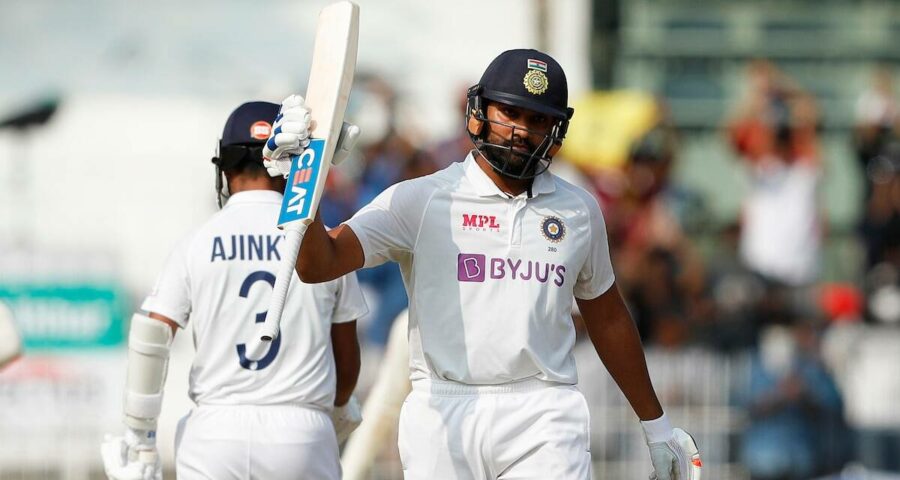While most others were struggling to survive on challenging tracks, Rohit showed his class to set up the two Indian victories.
“No, I don’t think so. The pitch didn’t do anything. Lots of the balls; batsmen got out to a straight ball. We made a lot of mistakes as a batting unit. We didn’t bat well. Pitch had nothing as such. No demons. It was a nice pitch to bat on. Once you are in you can score, as you saw (in the second innings). Apply and keep scoring on pitches like this,” Rohit Sharma said about the Motera pitch at the conclusion of the third Test, when he was asked about what did it took to survive on it.
Subject to interpretation, a cynical view about his comment could be that the India opener was only rubber-stamping the team management’s opinion of the pitch. After all, following the game finishing in 140.2 overs, skipper Virat Kohli had positive ratings for the surface. “… it was a very good pitch to bat on,” the India captain had said at the post-match presentation. Also, it has been reliably learnt that after losing the first Test, the Indian team demanded rank turners for the next two fixtures.
And yet, those who watched Rohit’s batting at close quarters in the second and third Tests would agree that he looked more comfortable than most on the challenging surfaces. If the early part of his innings at Chepauk still had a few near misses and strokes of luck, the pink-ball game gave an impression that he was on an evening stroll along the Sabarmati waterfront – as if he were playing on a different 22 yards – until he missed a sweep and got out. Rohit is a natural as far as batting is concerned and his comment about the pitch felt like an extension of his natural ability.
Many moons ago, when Kapil Dev was the coach of the Indian team, he had a conversation with medium pacer Thiru Kumaran during a training session. Back then, scribes were allowed on-field entry (outside the boundary line) and the conversation was audible. Kumaran was struggling to bowl outswingers and went to his coach for a solution. Kapil took the ball and off a run-up which wasn’t more than six-seven paces, bowled a perfect outswinger. It came naturally to the great allrounder, even after hanging up his playing boots. Rohit is probably Kapil’s batting equivalent in this Indian team.
Genuine match-winner
India have bounced back after losing the first Test and are currently with a 2-1 lead in the four-match series. Both wins have been set up by Rohit. His 161 at Chepauk was an unbelievable effort. The ball turned square from Day 1. The bounce was up and down, but the opener was going at almost run-a-ball during the first half of his innings. The adjudicators went by the numbers and picked Ravichandran Ashwin as the Man of the Match. No disrespect to Ashwin’s century in the second innings and an eight-wicket match haul, but Rohit’s masterly hundred was priceless. It was the reason why India notched up 300 on the first day. England were left to play catch-up from there on.
In the third Test, Axar Patel was adjudged Man of the Match for his 11-wicket match haul; on a surface where Joe Root’s part-time off-spin accounted for five wickets, giving away eight runs. The spin mayhem put Rohit’s 96-ball 66 in perspective – the batsman’s mastery over the conditions and his match-winning contribution. A mid-pitch conference between Rohit and Kohli during their 68-run first innings partnership was striking. The opener was the speaker and his captain the listener, respect and admiration being evident.
“Simplicity is excellence,” said former Pakistan skipper and batting great Zaheer Abbas. Rohit’s 66 in Ahmedabad wowed him.
“Simple things… He plays the ball on merit and doesn’t move his body at all. If you move your body, your balance is affected. Rohit is very still. He reads the pitch correctly and is mentally ready for these pitches. He has all the strokes in the book, which allows him keep the scoreboard moving. He picks the length early and his footwork allows him to dictate the spinners even on turning wickets. He is one of the all-time best against spin,” Abbas told The Indian Express.
At home on top
Since October 2019, when Rohit started opening the innings in the longest format, he has scored 981 runs in 10 Tests, including four centuries. In the ongoing series, he has scored 296 runs in three Tests. Ashwin’s tally of 176 runs is the next highest among Indians.
Apart from making winning impacts, Rohit has taken the pressure off the middle order. In Australia also, the starts he gave carried a positive trickle-down effect, although he failed to convert them into big scores. His overseas average, 27 (career average 46.65) is one area his critics love to point out, but according to Abbas, there’s very little flaw in his game against pace also. “Rohit is a complete batsman. He just needs to thrive on his confidence on overseas tours. This Indian team wins both home and away and Rohit is a match-winner,” he said.
Balance is key
Rohit had a clear plan in the first innings of the third Test. He scored off full and short deliveries and defended the good- length ones. Trying to play a sweep off a good-length delivery from Jack Leach that skidded off the surface was his only error in judgment.
Dilip Vengsarkar, too, spoke about Rohit’s balance. “As a batsman, Rohit is very nicely balanced, which is very important. He is absolutely precise, when he is going on the front foot or back foot. Besides, he has got an excellent defensive technique, which forms the base of his stroke-play also, so that he can play all the shots in the book with authority. His defensive technique and precise footwork give him a big chance to succeed against spinners on turning wickets. Add to this, his judgment – which ball is turning and which one is coming straight. This judgment separates the best of batsmen. He knows how to drop the wrists and keep the ball down, when it is turning and jumping,” Vengsarkar told this paper.
“It was bizarre that out of 30 wickets, 21 was to straight balls,” Kohli said post-match in Ahmedabad. Batsmen from both sides looked confused against the pink ball, unable to judge whether it would turn or skid. Rohit was unflustered. “He played late, allowing it to turn or come straight. He has mastered it,” Vengsarkar said.
Source: Read Full Article


